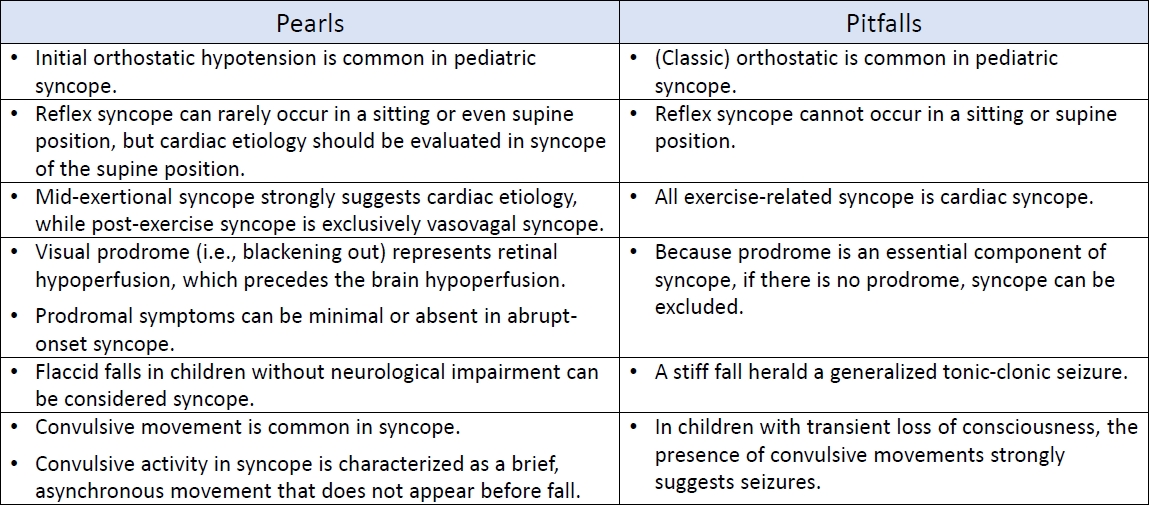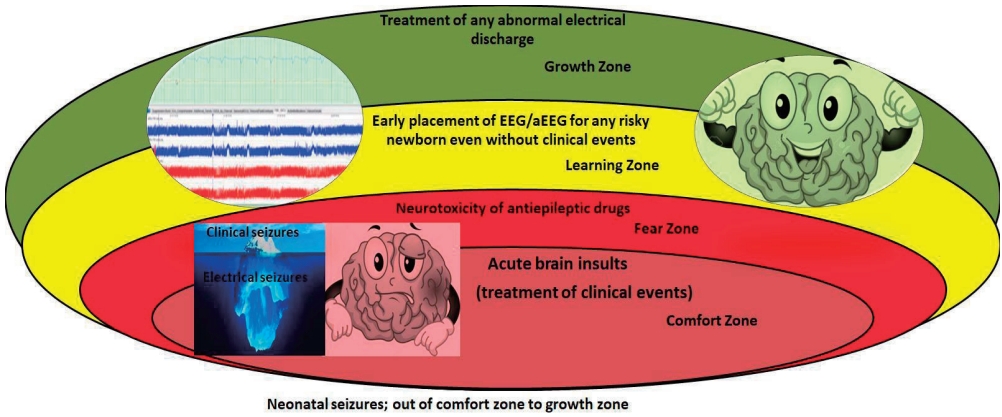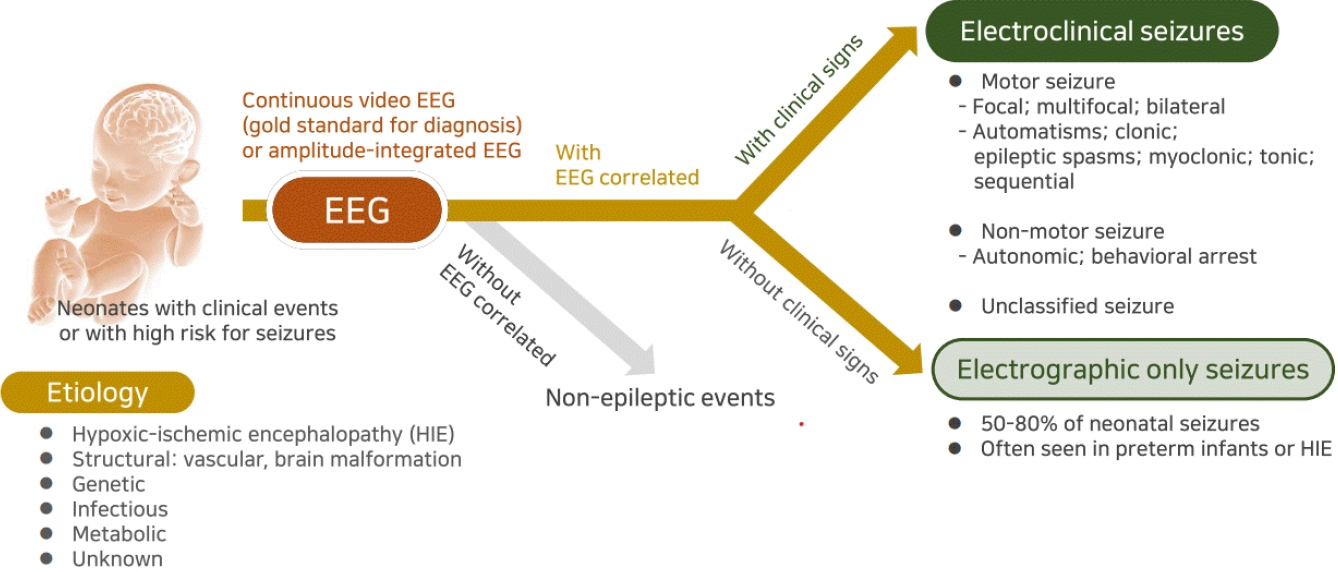Search
- Page Path
-
- HOME
- Search
- Original Article
- Neurology
- Changes in frequency of benign convulsions with mild gastroenteritis and their viral causes before and during the COVID-19 pandemic: a single-center study
- Hyejin Na, Sanghoon Lee, Seo Hee Kim, Young Ok Kim
- Clin Exp Pediatr. 2024;67(4):213-220. Published online March 19, 2024
-

Question: Did coronavirus disease 2019 (COVID-19) affect the frequency, seasonal variation, or virus type of benign convulsions with mild gastroenteritis (CwG)?
Findings: We compared 41 cases of CwG before and during the COVID-19 pandemic. After March 2020, frequency did not change significantly (18 patients vs. 23 patients), seasonal variation was lost, and number of cases of enteric adenovirus-associated CwG increased (1 cases vs. 7 cases).
Meaning: The COVID-19 pandemic affected CwG.
- Review Article
- Neurology
- Pediatric syncope: pearls and pitfalls in history taking
- Jung Sook Yeom, Hyang-Ok Woo
- Clin Exp Pediatr. 2023;66(3):88-97. Published online February 15, 2023
-

An accurate diagnosis depends on correct history taking and its interpretation. An in-depth understanding of the symptoms of syncope in connection with its pathophysiology can lead to avoiding critical pitfalls in the diagnostic process of history taking.
- Neonatology (Perinatology)
- Neonatal seizures: stepping outside the comfort zone
- Menna Hashish, Mohamed Reda Bassiouny
- Clin Exp Pediatr. 2022;65(11):521-528. Published online April 4, 2022
-

· Use conventional and amplitude-integrated electroencephalography to confirm clinical seizures and screen high-risk newborns.
· Select an explicit clear elective event to be treated with less toxic and more effective antiepileptics.
- Neurology
- Neonatal seizures: diagnostic updates based on new definition and classification
- Eun-Hee Kim, Jeongmin Shin, Byoung Kook Lee
- Clin Exp Pediatr. 2022;65(8):387-397. Published online April 4, 2022
-

· Neonatal seizures are often electrographic-only seizures without clinical signs; therefore, the identification of electrical seizure activity on electroencephalography is the gold standard for diagnosis.
· Clinical signs of neonatal seizures are divided into motor or nonmotor seizures, and motor seizures are mostly focal or multifocal.
· Most neonatal seizures are caused by acute symptomatic etiologies, but in cases of intractable seizures, structural, genetic, or metabolic etiologies should be investigated.
- Update on benign convulsions with mild gastroenteritis
- Yeong Seok Lee, Ga Hee Lee, Young Se Kwon
- Clin Exp Pediatr. 2022;65(10):469-475. Published online December 27, 2021
-

∙ The main pathogen for benign convulsions with mild gastroenteritis (CwG) was previously rotavirus; however, cases associated with norovirus are increasing.
∙ CwG is characterized by clustered generalized seizures. Electroencephalography and magnetic resonance imaging show transiently abnormal findings in the acute phase that eventually normalize with progression. Its prognosis is good, and long-term treatment is unnecessary.
∙ There are many reports on the pathophysiological mechanism of CwG, which remains unclear.
- Original Article
- Neurology
- Effects of lamotrigine on attention-deficit hyperactivity disorder in pediatric epilepsy patients
- Seung-A Han, Eu Jeen Yang, Mi-Kyoung Song, Sun Jun Kim
- Clin Exp Pediatr. 2017;60(6):189-195. Published online June 22, 2017
-
Purpose The purpose of this study was to investigate the effects of lamotrigine for the treatment of attention-deficit hyperactivity disorder (ADHD) symptoms in children with epilepsy.
Methods Pediatric patients newly diagnosed with epilepsy (n=90 [61 boys and 29 girls]; mean age, 9.1±3.4 years) were enrolled. All patients were evaluated with the Korean ADHD rating scale (K-ARS)-IV before treatment with lamotrigine and after doses...
- Case Report
- Neurology
- 1p36 deletion syndrome confirmed by fluorescence
in situ hybridization and array-comparative genomic hybridization analysis - Dong Soo Kang, Eunsim Shin, Jeesuk Yu
- Clin Exp Pediatr. 2016;59(Suppl 1):S14-S18. Published online November 30, 2016
-
Pediatric epilepsy can be caused by various conditions, including specific syndromes. 1p36 deletion syndrome is reported in 1 in 5,000–10,000 newborns, and its characteristic clinical features include developmental delay, mental retardation, hypotonia, congenital heart defects, seizure, and facial dysmorphism. However, detection of the terminal deletion in chromosome 1p by conventional G-banded karyotyping is difficult. Here we present a case of...
- Review Article
- Neurology
- White matter injury following rotavirus infection in neonates: new aspects to a forgotten entity, 'fifth day fits'?
- Jung Sook Yeom, Chan-Hoo Park
- Clin Exp Pediatr. 2016;59(7):285-291. Published online July 31, 2016
-
That rotavirus infection can cause neurological symptoms in young children has been well established. However, it is surprising why rotavirus infection has been overlooked as a cause of neonatal seizures for many years, despite significant research interest in neonatal rotavirus infection. Neonates are the age group most vulnerable to seizures, which are typically attributed to a wide range of causes....
- Original Article
- Neurology
- Intravenous levetiracetam versus phenobarbital in children with status epilepticus or acute repetitive seizures
- Yun-Jeong Lee, Mi-Sun Yum, Eun-Hee Kim, Tae-Sung Ko
- Clin Exp Pediatr. 2016;59(1):35-39. Published online January 22, 2016
-
Purpose This study compared the efficacy and tolerability of intravenous (i.v.) phenobarbital (PHB) and i.v. levetiracetam (LEV) in children with status epilepticus (SE) or acute repetitive seizure (ARS).
Methods The medical records of children (age range, 1 month to 15 years) treated with i.v. PHB or LEV for SE or ARS at our single tertiary center were retrospectively reviewed. Seizure termination was defined...
- Serum interleukin-1beta and tumor necrosis factor-alpha in febrile seizures: is there a link?
- Abolfazl Mahyar, Parviz Ayazi, Reza Orangpour, Mohammad Mahdi Daneshi-Kohan, Mohammad Reza Sarokhani, Amir Javadi, Morteza Habibi, Mousa Talebi-Bakhshayesh
- Clin Exp Pediatr. 2014;57(10):440-444. Published online October 31, 2014
-
Purpose Febrile seizures are induced by fever and are the most common type of seizures in children. Although numerous studies have been performed on febrile seizures, their pathophysiology remains unclear. Recent studies have shown that cytokines may play a role in the pathogenesis of febrile seizures. The present study was conducted to identify potential links between serum interleukin-1beta (IL-1β), tumor necrosis...
- Review Article
- Febrile seizures
- Sajun Chung
- Clin Exp Pediatr. 2014;57(9):384-395. Published online September 30, 2014
-
Febrile seizure (FS) is the most common seizure disorder of childhood, and occurs in an age-related manner. FS are classified into simple and complex. FS has a multifactorial inheritance, suggesting that both genetic and environmental factors are causative. Various animal models have elucidated the pathophysiological mechanisms of FS. Risk factors for a first FS are a family history of the...
- Benign convulsion with mild gastroenteritis
- Ben Kang, Young Se Kwon
- Clin Exp Pediatr. 2014;57(7):304-309. Published online July 23, 2014
-
Benign convulsion with mild gastroenteritis (CwG) is a type of afebrile seizure that occurs in children. CwG is defined as a convulsion in a previously healthy child with no known central nervous system infection or encephalopathy, accompanying mild diarrhea without fever, electrolyte imbalance, or moderate to severe dehydration. Convulsions in CwG are characterized by multiple brief episodes of generalized or...
- Original Article
- Early postictal electroencephalography and correlation with clinical findings in children with febrile seizures
- Kyung A Jeong, Myung Hee Han, Eun Hye Lee, Sajun Chung
- Clin Exp Pediatr. 2013;56(12):534-539. Published online December 20, 2013
-
Purpose Electroencephalography (EEG) is frequently ordered for patients with febrile seizures despite its unclear diagnostic value. We evaluated the prevalence of abnormal EEGs, the association between clinical findings and abnormal EEGs, and the predictive value of EEG for the recurrence of febrile seizures.
Methods Data were collected on 230 children who were treated for febrile seizures at Kyung Hee University Medical Center from...
- Review Article
- The role of cytokines in seizures: interleukin (IL)-1β, IL-1Ra, IL-8, and IL-10
- Youngah Youn, In Kyung Sung, In Goo Lee
- Clin Exp Pediatr. 2013;56(7):271-274. Published online July 19, 2013
-
Brain insults, including neurotrauma, infection, and perinatal injuries such as hypoxic ischemic encephalopathy, generate inflammation in the brain. These inflammatory cascades induce a wide spectrum of cytokines, which can cause neuron degeneration, have neurotoxic effects on brain tissue, and lead to the development of seizures, even if they are subclinical and occur at birth. Cytokines are secreted by the glial...
- Original Article
- Selenium and leptin levels in febrile seizure: a case-control study in children
- Abolfazl Khoshdel, Neda Parvin, Maedeh Abbasi
- Clin Exp Pediatr. 2013;56(2):80-85. Published online February 25, 2013
-
Purpose Febrile seizures (FS) are seizures that occur between the age of 6 and 60 months, but its pathophysiology still is not fully understood. There is limited information about the correlation between levels of selenium and leptin with FS. This study aimed to determine the relationship between serum levels of selenium and leptin in children with FS.
Methods This case-control study was conducted...
- Review Article
- Cognitive function of idiopathic childhood epilepsy
- Su Jeong You
- Clin Exp Pediatr. 2012;55(5):159-163. Published online May 21, 2012
-
Most children with epilepsy are of normal intelligence. However, a significant subset will have temporary or permanent cognitive impairment. Factors that affect cognitive function are myriad and include the underlying neuropathology of the epilepsy, seizures, epileptiform discharges, psychosocial problems, age at seizure onset, duration of epilepsy, and side effects associated with antiepileptic drugs. This review article discusses cognitive function in...
- Case Report
- A case of Hashimoto's encephalopathy presenting with seizures and psychosis
- Min-Joo Lee, Hae-Sang Lee, Jin-Soon Hwang, Da-Eun Jung
- Clin Exp Pediatr. 2012;55(3):111-113. Published online March 16, 2012
-
Hashimoto's encephalopathy (HE) is a rare, poorly understood, autoimmune disease characterized by symptoms of acute or subacute encephalopathy associated with increased anti-thyroid antibody levels. Here, we report a case of a 14-year-old girl with HE and briefly review the literature. The patient presented with acute mental changes and seizures, but no evidence of infectious encephalitis. In the acute stage, the...
- Transient splenial lesion of the corpus callosum in a case of benign convulsion associated with rotaviral gastroenteritis
- Yoon Young Jang, Kye Hyang Lee
- Clin Exp Pediatr. 2010;53(9):859-862. Published online September 13, 2010
-
Transient magnetic resonance (MR) signal changes in the splenium of the corpus callosum (SCC) arise from many different conditions, including encephalopathy or encephalitis caused by infection, seizures, metabolic derangements, and asphyxia. Few case reports exist on reversible SCC lesions associated with rotavirus infection. A benign convulsion with mild gastroenteritis (CwG) is frequently associated with rotaviral infections. This entity is characterized...
- Review Article
- Diagnosis of neonatal seizures
- Hee Jung Chung, Yun Jung Hur
- Clin Exp Pediatr. 2009;52(9):964-970. Published online September 15, 2009
-
Neonatal seizures are generally not only brief and subtle but also not easily recognized and are usually untreated. In sick neonates, seizures are frequently not manifested clinically but are detected only by electroencephalography (subclinical EEG seizures). This phenomenon of electroclinical dissociation is fairly common in neonates. On the other hand, neonates frequently show clinical behaviors such as stiffening, apnea, or... -
- Neonatal seizures in Korea, 1983-2009
- Eun Sook Suh
- Clin Exp Pediatr. 2009;52(9):957-963. Published online September 15, 2009
-
Neonatal seizures are the most common and distinctive clinical sign of prenatal and/or neonatal brain disorders. Newborn infants with seizures are at risk of mortality and survivors at risk for neurologic impairment, developmental delay, and subsequent epilepsy. Fifteen reports on neonatal seizures in Korea from 1983 to 2009 were analyzed. A total of 731 neonatal seizure cases were reported. Day... -
- Case Report
- Reflex seizures induced by micturition : A pediatric case and ictal EEG finding
- Young Il Rho
- Clin Exp Pediatr. 2008;51(12):1346-1349. Published online December 15, 2008
-
Reflex seizures induced by micturition are rare, and there have been few reports on ictal electroencephalogram (EEG) findings. Here, we report a 7-year-old boy with secondarily generalized partial seizures induced by micturition. The seizures occurred every time he urinated. A few seconds after micturition begun, he toppled down with hand automatism followed by a secondarily generalized tonic posture and loss... -
- Original Article
- Polymorphisms of interleukin-1β promoter in simple febrile seizures
- Jang Won Yoon, Eun Jung Choen, Young Hyuk Lee
- Clin Exp Pediatr. 2008;51(9):1007-1011. Published online September 15, 2008
-
Purpose : Febrile seizure (FS) is the most common type of seizure. The role of genetic factors in FSs has long been recognized. A positive family history can be elicited in 25-40% of patients with FSs; nonetheless, the genes responsible for FSs in the majority of the population remain unknown. Interleukin-1β (IL-1β) is a pro-inflammatory cytokine that acts as an... -
- Review Article
- Non-epileptic paroxysmal events during sleep - Differentiation from epileptic seizures -
- In Kyu Lee
- Clin Exp Pediatr. 2007;50(8):726-731. Published online August 15, 2007
-
This review describes the wide spectrum of paroxysmal events during sleep in infancy and childhood. The differential diagnosis between sleep-related non-epileptic paroxysmal events and epileptic seizures is difficult in special occasions. The nocturnal frontal lobe seizure and of the more common non- epileptic paroxysmal events during sleep are described. The main differentiating features characterizing parasomnias are: onset in early... -
- Original Article
- A comparison of provoked seizures and febrile seizures associated with minor infections
- Eun-Ju Lee, Won Seop Kim
- Clin Exp Pediatr. 2007;50(4):376-380. Published online April 15, 2007
-
Purpose : Febrile seizures occur in childhood associated with a febrile illness not caused by infections of the central nervous system. Provoked seizures are identified with seizures in association with infections that do not usually affect the brain such as gastroenteritis, except criteria for other febrile seizures in this study. We studied seizures provoked by minor extracranial infections, to contrast... -
- Clinical Characteristics of Neonatal Status Epilepticus
- Kyeong Hun Jung, Yun Hee Kim, Young Se Kwon, Yong Hoon Jun, Soon Ki Kim, Byong Kwan Son
- Clin Exp Pediatr. 2005;48(12):1342-1347. Published online December 15, 2005
-
Purpose : Among perinatal risk factors, neonatal seizures are one of the strongest independent discriminators of adverse outcome, representing high risks of mortality and neurologic morbidity. This study was undertaken to evaluate the neurologic outcome of neonatal status epilepticus according to underlying etiology, seizure pattern, onset time, and duration. Methods : We reviewed retrospectively 36 neonates(19 males, 17 females) with status... -
- A Clinical Study on the Etiologies of Acute Seizures in Children Who Visited Emergency Department
- Jung Il Cho, Dong Wook Kim, Hyun Oh Jang, Jin Soo Moon, Seung Yeon Nam, Seung Yeon Nam
- Clin Exp Pediatr. 2004;47(12):1312-1318. Published online December 15, 2004
-
Purpose : Although it is important to know the etiologies of childhood seizures according to age, clinical studies on this topic have been few. The present study was therefore designed to investigate the causes of acute childhood seizures. We hope this study will be helpful in the diagnosis and management of children with seizures. Methods : This study was retrospectively undertaken... -
- Urine Organic Acid Analysis of Patients with Febrile Seizures
- Dong Soo Shin, Gun Jun Lee, Kyeung Ja Lee, Won Il Park, Eun Joo Bae, Hong Gin Lee
- Clin Exp Pediatr. 2004;47(11):1205-1209. Published online November 15, 2004
-
Purpose : Febrile seizure, the most common seizure disorder in children between 6 months and 5 years of age, is mostly caused by viral infections, except severe CNS infection. It can also be caused by disorders in organic acid metabolism, especially accompanied by fever. Therefore we decided to investigate the relationship between children with febrile seizures and disorders in organic... -
- CSF Examination in the First Febrile Seizure
- Joseph Jo, Sun Hee Yu, Young Taek Jang
- Clin Exp Pediatr. 2004;47(7):762-767. Published online July 15, 2004
-
Purpose : This study was launched to classify subjects of the CSF examination and improve early diagnosis of meningitis and its treatment in children who have had a first febrile seizure. Methods : From March 1995 to September 2003, children aged 3 months to 5 years who had had treatment for febrile seizure were analyzed as to their age at first... -
- Clinical Characteristics and Prognosis of Neonatal Seizures
- Chang Wu Kim, Chang Hwan Jang, Heng Mi Kim, Byung Ho Choe, Soon Hak Kwon
- Clin Exp Pediatr. 2003;46(12):1253-1259. Published online December 15, 2003
-
Backgroud : Seizures in the neonate are relatively common and their clinical features are different from those in children and adults. The study aimed to provide the clinical profiles of neonatal seizure in our hospital. Methods : A total of 41 newborns with seizures were enrolled in this study over a period of three years. They were evaluated with special reference... -
- Recurrence Rate of Febrile Seizures by Combining Risk Factors
- Su Jung Moon, Gu Ken Sun, Eun Young Kim, Kyong Hee Na, Sun Young Park, Kyoung Sim Kim, Yong Wook Kim
- Clin Exp Pediatr. 2002;45(11):1403-1410. Published online November 15, 2002
-
Purpose : In previous studies, various risk factors for recurrent febrile seizures have been identified. But none of these risk factors alone could sufficiently discriminate children at high or low risk for recurrent seizures. Therefore, we tried to identify patients at high risk of recurrent febrile seizures by combining risk factors. Methods : Two hundred and four children who had... -
-

-
-

-

-
Impact Factor3.2
-
8.02023CiteScore94nd percentilePowered by







